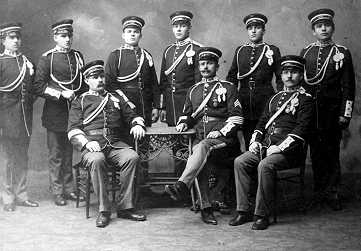

UNIT HISTORY:
The 65th New York mustered at Buffalo, N.Y. At the time of being mustered in, the unit consisted of 50 officers and 980 enlisted men. The 65th New York would eventually expand to include a total of 46 officers and 1242 enlisted men. The unit was sent to Camp Alger, Virginia, just outside of Washington DC and was assigned to the assigned to the First Brigade, 2nd (?) Division, 2nd Army Corps. Orginally, it was thought that units stationed at Camp Alger, named for the secretary of war, would form the backbone of the Cuban Invasion army. Though this did not become true, some of the units stationed at Camp Alger would see Cuba. The 65th New York, however, was not among them. Many of the New York volunteer regiments lacked basic items such as tents, mess kits, etc. So much equipment was needed that late in May, none of the volunteer regiments at the Camp Alger were ready to take the field in war.

Camp Alger did not have its individual cams spread out, but had them paced closely together. There wer packed so closely that on June 1, the camp of the 65th New York was relocated, to allow for space for drilling, parades, etc. It had been encamped just south of the Corps headquarters, but was moved to a little less than a half mile north of the headquarters. While in crowded camp Alger, the men of the 65th New York would have spent their time in company, brigade and regimental and battalion drills, target practice, etc. The major enemies they faced were disease and boredom. A fringe of saloons, restaurants, gambling dens and worse opened around the camp, tempting many of the bored, frustrated men.
Conditions in Camp Alger began to deteriorate from overcrowding, lack of sanitary conditions, etc. Supplies could not be delivered by rail, since the rail lines ended some distance from the camp. Men had to march seven miles to bathe. Typhoid broke out. The conditions in the camp began to attract the interest of the newspapers, and, combined with the terrible conditions in other camps, became a national disgrace. In mid-August, with Camp Alger swelling to over 23,500 men, the 2nd Corps was moved to Camp Meade, in Middletown, Pennsylvania.
The records do no show if the 65th New York made the trip to Camp Meade. Presumably it did, but the 65th's camp is not indicated on the maps of the camp. Regardless, the fighting had ended just as the 2nd Corps began its movement to Camp Meade. An armistice with Spain had been agreed to on August 13. On December 10, the war ended with the Treaty of Paris. By this time, the men of the 65th New York would have been home.
During its term of service, the 65th New York Volunteer Infantry
had seventeen men die of disease, had another 23 discharged for reasons
of disalbility, had two men courtmartialled, and twelve men desert.
(As a service to our readers, clicking on title in red will take you to that book on Amazon.com)
Clerk of Joint Committee on Printing, The Abridgement of Message from the President of the United States to the Two Houses of Congress. (Washington: Government Printing Office, 1899) Vol 3, 461, 493, map accompanying report of William Graham, (opp page 484).
Cosmas, Graham A., An Army for Empire : The United States Army in the Spanish American War. (Shippensburg, PA: White Mane Publishing Co., 1993). 120, 267.
Hanes, Nancy, photo of the unit during the war (which includes her great grandfather, John Buehringer)
Hill, Claudia, Image of the 65th New York with her great-great-grandfather, Frank Romanowski with others in dress uniforms.
Statistical Exhibit of Strength of Volunteer Forces Called into
Service During the War with Spain; with Losses from
All Causes. (Washington: Government Printing Office, 1899).

